Our third stop in Greece was in Mykonos, a Greek island famous for its white buildings with accented roofs and doors, beaches, and night life.
We arrived early (7:00 am) and had to meet for our excursion at 7:15. We struggled to get up as Toren woke up repeatedly through the night and only made it in time because Rosemary knocked on our door. We had different excursions this day as well. Brent, Suzy, and Ethan opted for the beaches of Mykonos while the rest of us headed to the island of Delos, one of the most important mythological and archaeological sites in Greece. Delos is about 20-30 minutes away from Mykonos by boat. Delos was a holy site long before Greek mythology turned it into the birthplace of both Apollo and Artemis. At its apex, almost the entire island was covered with one massive, booming city. According to our guide, there were over 60,000 inhabitants (today there are 14). It was covered with temples and monuments, most of which have been raided. Since 1872, the French School of Athens has been excavating the island. The island is fascinating because it has very few natural resources – no timber or arable land as it is too dry. What little water the island has is stored in cisterns and the dirty water is managed through a complex sewer system (that actually runs under the cities streets; you can see it through the cracks in the rocks). All the resources used by the inhabitants were shipped in, which was obviously a considerable amount considering the size of the population. Delos was also quite multicultural as the Romans eliminated taxes on the island. Everyone from the Naxos/Cycladic Culture (who were quite powerful before the Greek Athenians came to power; our guide was from Naxos and talked about it a lot) to the Egyptians set up shops and temples here.
Unfortunately, the place has basically been ransacked and most of the amazing artwork and sculpture has been taken by looters, but it’s still pretty amazing. One of the first things our guide showed us was a portico donated by King Philip V of Macedonia, which still has the Greek writing on it indicating that he gave it as a gift to the island, the visitors of the island, and the gods. Here’s the portico today:
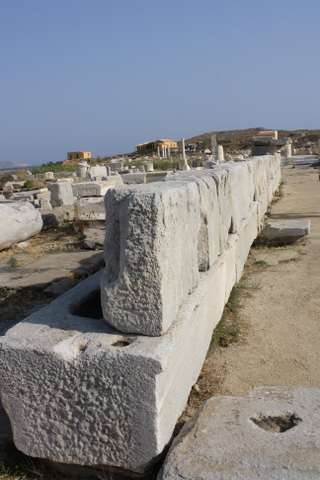
Another remarkable site are the famed lions donated by the Naxos, which haven’t weathered well, but are still quite impressive considering they are close to 4,000 years old:
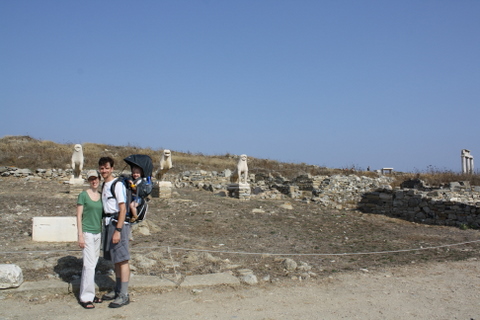
Our guide also pointed out a still-standing herm (or herma), which is a squared statue with a head (typically of Hermes, the messenger god and protector of merchants and travelers). More interestingly, the genitalia were also typically part of the sculpture and occasionally the erect penis held a sign with information or directions (the one below, unfortunately, is sans phallus):
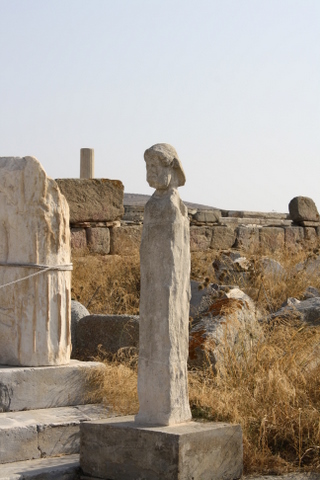
I think life would be more interesting if all of our road and information signs were herms today. Don’t you?
As I mentioned, Delos is known for being the birthplace of Apollo. According to Greek mythology, Leto, Apollo’s mother, was banned from giving birth on “terra firma” by Hera (Zeus’s wife; Zeus was the father, that scoundrel). Delos was a newly created floating island at the time. Leto found Delos and gave birth in the middle of the sacred lake, holding a palm tree, first to Artemis, and then to Apollo. The sacred lake has been drained to prevent the spread of disease, but the lake bed is still there and there is a palm tree in the center:
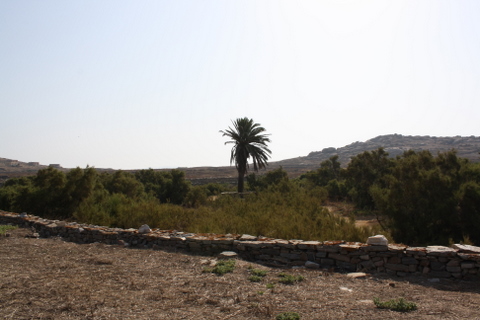
Here we are at the birthplace of Apollo and Artemis:
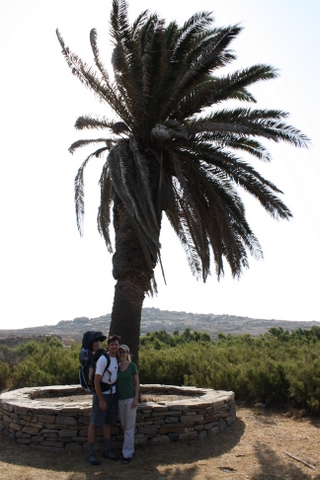
I’ve never visited the birthplace of a god before! How cool is that?!?
Another temple had two very large phalluses standing guard at the entrance. The phallus was often revered by the Greeks, who saw it as a symbol of fertility. Unfortunately, they were both broken:
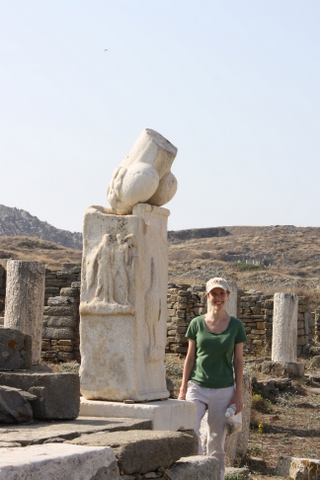
From here we wandered into the ruins, visiting houses dedicated to various gods and other figures. We visited homes dedicated to Trident, Poseidon, and a Cleopatra, but not “that” Cleopatra. We eventually worked our way up to the very large amphitheater. However, on the way Toren started getting antsy, so he and I took off and left the rest of the group, climbing around the ruins. We actually climbed to the top of the amphitheater before our group arrived and took this shot of the group as they entered:
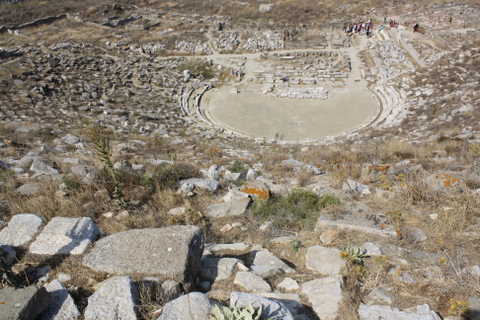
Steve, in turn, took a shot of Toren and I at the top of the amphitheater:
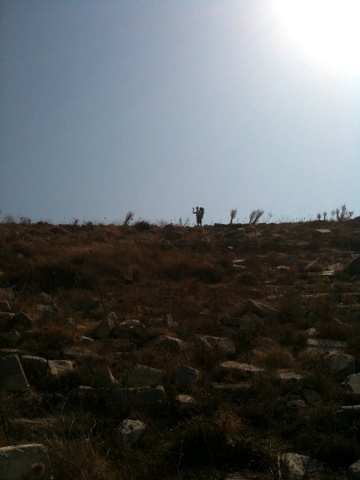
The tour ended at the amphitheater. Our guide, who was really good by the way, had noted that the mountain at the center of the island was called Mount Cynthus, which is the root for Cynthia, which is a different version of the name Artemis. We could see the mountain in the distance and noted that there was a path to climb it:
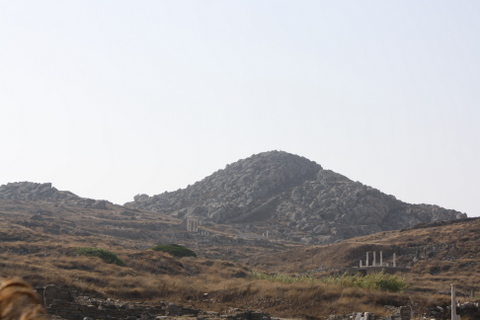
I asked the guide if we could climb it. He said yes and that it was an easy climb. Gary, Rosemary, and Debi weren’t interested, so I left Toren with them at the amphitheater and Steve and I set out to climb Mount Cynthos. Twenty minutes later we were at the top:
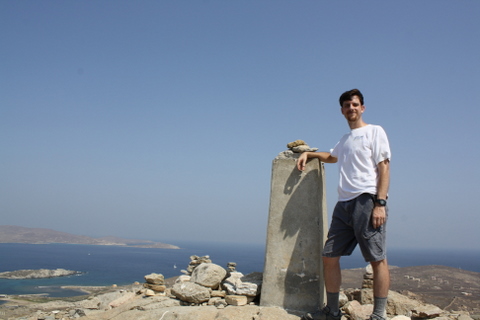
While up here I took a number of pictures to build a panorama of the great view, which I pieced into two photos:


If you look closely in the panoramas you’ll see rock walls running the length of the island. As I noted above, the entire island was at one point inhabited, but only a small portion has been excavated. The wall illustrates that the ruins do cover the entire island. The island was, like most things pagan, abandoned with the spread of Christianity (the exception being temples that were converted to churches).
On our way to Mount Cynthos I saw a temple about half way up the mountain that no one was visiting. On our way back down we found the path to it and worked our way over to it. Turns out it isn’t a temple but the ancient entry to Mount Cynthos:
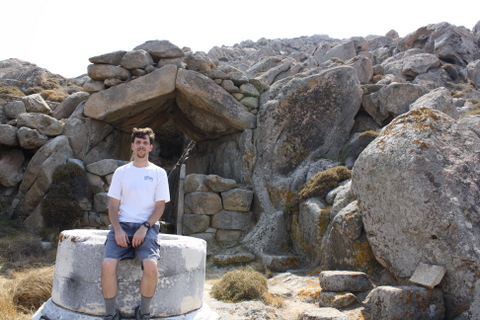
We hiked back down the mountain and met back up with everyone at the amphitheater. Toren was having a ball running around the amphitheater but was excited to see me:
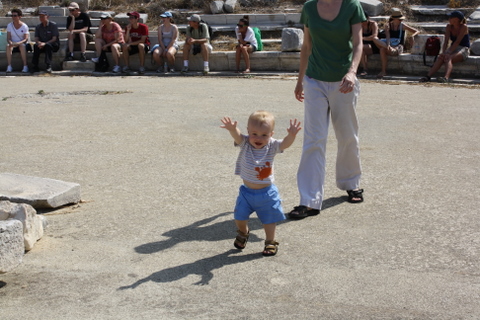
By this point we had about 30 minutes until we had to be back on the boat. Debi, Steve, Toren, and I ran over to the museum, which houses the more sensitive sculptures and decorations that have been preserved from the ruins. We didn’t have much time, but worked through the museum quickly. A lot of the ancient artifacts have been plundered over the years, so not much remains. We then got back on our boat and headed back to Mykonos.
We walked around Mykonos for a little bit, following the boardwalk to the nearby beach. We also walked through some of the of the narrow back streets (stopping to buy some more wipes for Toren; we were running low). We also found a free wifi hotspot, so Steve and I stopped to check our email for a few minutes. We then headed back to the ship and grabbed a bite to eat at the buffet.
Mykonos does look very cool with the nearly uniform white buildings with various colored accents. The uniformity makes it very quaint. Brent and Suzy said the beach was nice – not great sand, but the water was very clear. Oh, and they went to a “family” beach; there are “adult” beaches too.
As was quickly becoming the pattern, we took a nap in the afternoon, waking up in time to get ready for dinner. It was the second and last formal night, so Toren got fancied up in his tuxedo again. We didn’t get as many pictures this time as he was still tired, but we snapped a few:
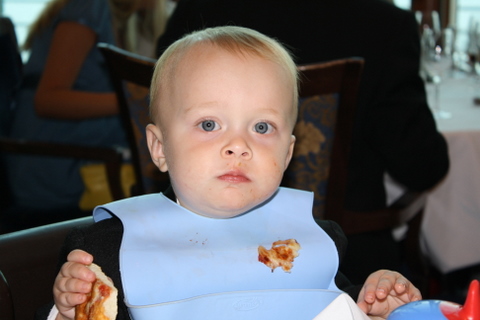
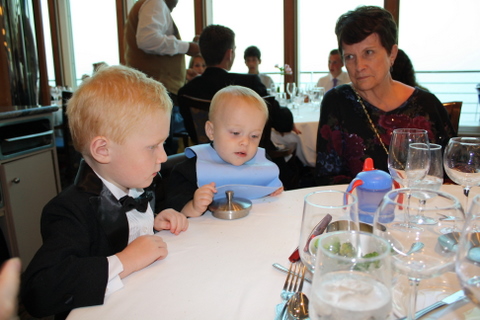
We tried to go dancing again this night, but Toren wasn’t game. Rosemary was with us and every time we’d start dancing, Toren would run out on to the dance floor and grab Debi. So we called it a night and just went back to the room to put Toren down then fell asleep ourselves.
![]()
Leave a Reply